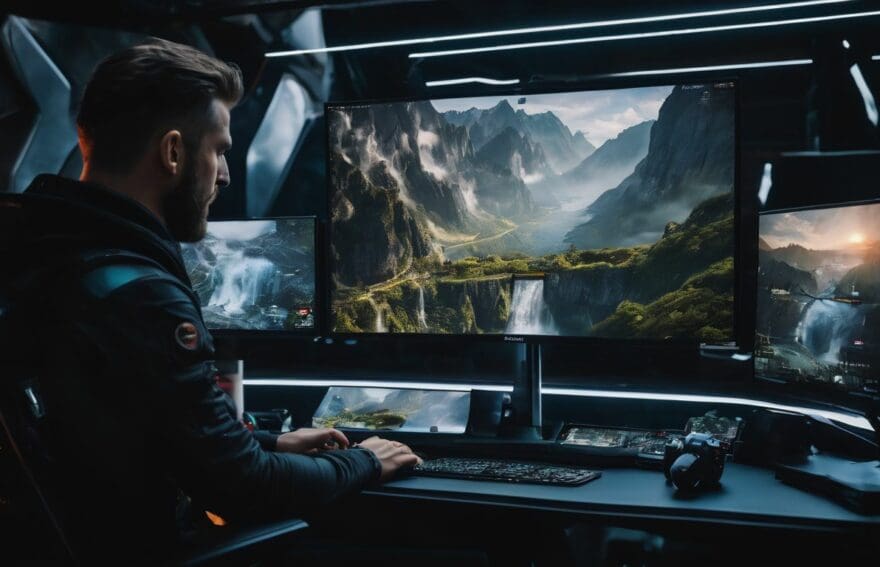The Evolution of User Interfaces in Esports Platforms

Updated On: November 13, 2025 by Aaron Connolly
Have you ever found yourself a touch bewildered amidst the whirlwind of change that is esports interfaces? Rest assured, you are in splendid company. As an impassioned collective of gamers and tech aficionados, we have plunged headfirst into the dynamic terrains of gaming platforms.
Banish those fears, for our article is akin to a trusty lantern, casting light on the journey from humble pixelated beginnings to sleek modern interfaces that elevate our digital skirmishes.
Brace yourselves to delve into the transformative realm of esports UI – it’s nothing short of revolutionary!
The Evolution of User Interfaces in Esports Platforms
The evolution of user interfaces in esports platforms has been a fascinating journey, starting from the birth of game UI in the 1960s to the introduction of colour in the 1980s and the impact of 3D graphics.
This evolution has significantly shaped the way gamers interact with virtual worlds on various gaming platforms.
The Birth of Game UI in the 1960s
In the swinging 60s, we saw the debut of video game UI as developers began exploring interactive electronic entertainment. Early arcade machines and primitive computer games introduced basic interfaces, with simple visuals like Pong’s iconic paddles and ball.
These were thrilling times—everything was new, every design choice paved way for future gaming interface trends.
We experimented with on-screen scoring, player lives indicators, and level progress—all rudimentary but essential elements that formed the backbone of today’s dynamic gaming user interaction.
This era set a foundation that would dramatically shape virtual world interactions in games to come. Designers learned to create intuitive controls within limited technological capabilities, laying down principles of interactive design still relevant in our play experiences today.
Introduction of Colour in the 1980s
Moving on from the monochromatic interface of the 1960s, the 1980s marked a significant shift in gaming experiences with the introduction of colour. This development not only enhanced visual appeal but also contributed to a more immersive and engaging user experience for gamers.
The incorporation of vibrant colours brought new life to game graphics and environments, allowing players to interact with virtual worlds in increasingly dynamic ways.
This shift towards colourful interfaces also reflected advancements in technology during this era, as gaming platforms could now support more complex graphics and animations. As a result, game developers began exploring innovative ways to utilise colour to convey information, set moods, and create visually captivating scenarios within different game genres.
Impact of 3D Graphics
3D graphics have revolutionised the gaming experience, immersing players in virtual worlds with stunning visual effects. This technology has enhanced game navigation and created more realistic environments for gamers to explore.
With 3D graphics, game developers can now design intricate virtual landscapes that bring a new level of depth and detail to gameplay. The introduction of 3D visuals has significantly elevated the overall user experience, providing an unparalleled sense of immersion and interactivity.
As we delve into the rise of esports platforms, it becomes evident how 3D graphics have fundamentally transformed the visual appeal and engagement factor in gaming interfaces, capturing players’ attention and elevating their gaming experiences to new heights.
Rise of Esports Platforms
PC gaming has revolutionised the way we interact with games, offering customisable interfaces and controls. Mobile gaming has brought touch interfaces to the forefront, while consoles have incorporated motion sensors for a more immersive experience.
PC Gaming and Customisation
PC gaming offers a plethora of opportunities for customisation, allowing players to tailor their gaming experience according to their preferences. From adjusting graphics settings and controls to modding games, the flexibility of PC gaming enables users to create a personalised environment that suits their individual needs.
This level of customisation not only enhances the gameplay experience but also fosters a sense of ownership and creativity among gamers.
Customisable hardware is another key aspect of PC gaming, with enthusiasts having the freedom to build their own rigs or upgrade components based on their specific requirements. This hands-on approach not only provides a deeper understanding of technology but also allows gamers to push boundaries and explore new possibilities in enhancing performance and visual quality.
Mobile Gaming and Touch Interfaces
In contrast to the customisation options in PC gaming, mobile gaming has brought about a revolution in user interfaces through touch interfaces. This new interface design has allowed for more intuitive and immersive controls, creating an interactive platform that is accessible to both passionate gamers and novice players alike.
The introduction of touch-based interactions has provided a more tactile and engaging experience for users, further enhancing the overall gaming experience.
Additionally, the evolution of touch interfaces in mobile gaming has led to the development of games tailored specifically for this medium, offering unique gameplay experiences that leverage gesture-based controls and multi-touch functionalities.
Consoles and Motion Sensors
Gaming consoles have revolutionised the gaming experience for players, offering a diverse range of interfaces and controls tailored to specific game genres. The integration of motion sensors in consoles has further enhanced player engagement by enabling physical movements to control in-game actions, adding an immersive dimension to gameplay.
This evolution has opened up new possibilities for user interaction and has contributed significantly to the advancement of esports platforms, catering to a broader audience and creating opportunities for innovative gaming experiences.
Moreover, the introduction of motion sensors has allowed users to engage with games in a more dynamic and interactive manner. This technological innovation not only adds a layer of physicality but also provides an intuitive interface that aligns with human movement, enriching the overall gaming experience.
Impact of Technology on Esports UI
Esports UI has experienced significant impact from advancements in technology, including the integration of VR and AR, improved graphics and animation, and a shift towards user-centric design.
To learn more about these exciting developments, keep reading!
VR and AR Integration
VR and AR integration has revolutionised the esports industry, offering immersive experiences for players. These technologies have opened up a whole new world of interactive gameplay, allowing users to feel like they are truly part of the gaming environment.
The incorporation of VR and AR into esports platforms has significantly enhanced user experience design, bringing a new level of excitement and engagement to gaming.
Gaming technology has advanced rapidly in recent years, driving the development of VR and AR integration in esports. These advancements have not only transformed how games are played but also elevated the overall quality of user interface design and interaction within e-sports platforms.
Improved Graphics and Animation
Improved graphics and animation have revolutionised the visual experience of esports platforms. The advancements in 3D graphics technology have brought games to life with stunning detail and realism, captivating players and viewers alike.
With more powerful hardware and sophisticated software tools, game developers can create intricate environments, lifelike character designs, and fluid animations that enhance the overall gaming experience.
The integration of improved graphics and animation has not only raised the bar for visual quality but also contributed to immersive storytelling in video games. From dynamic lighting effects to seamless character movements, these enhancements elevate the level of engagement for gamers while creating a visually appealing spectacle for spectators.
User-Centric Design
Esports platforms have embraced user-centric design to enhance the gaming experience for players and viewers alike. By prioritising the needs and preferences of users, interfaces are being tailored to provide intuitive navigation, customisable options, and seamless interactions.
This approach ensures that gamers, both novice and experienced, can easily access features, customise settings, and engage with the game in a way that suits their individual preferences.
The evolution of user interfaces in esports platforms has been driven by a focus on enhancing user experience through thoughtful design elements that prioritise accessibility and inclusivity.
Gaming technology continues to evolve rapidly, inspiring esports platforms to integrate AI-driven personalisation features which adapt to individual playing styles and behaviours. Additionally, haptic feedback is poised to revolutionise user experiences by providing tactile sensations that complement visual and auditory stimuli.
Current Trends in Esports UI
Esports UI designs are now incorporating customisable layouts and controls, allowing players to personalise their gaming experience. There’s also a growing trend of integrating social media elements into esports platforms, creating a more interactive and connected community for gamers.
Customisable Layouts and Controls
Esports platforms offer customisable layouts and controls, allowing players to personalise their gaming experience. This feature caters to diverse player preferences and enhances user engagement.
Players can adjust the layout of on-screen elements and remap controls according to their individual play style, contributing to a more immersive and enjoyable gaming experience.
The option for customisable layouts and controls aligns with the growing emphasis on user-centric design in esports interfaces. This trend reflects the industry’s commitment to providing accessible and inclusive experiences for all gamers, regardless of skill level or physical abilities.
Integration of Social Media
Esports platforms are increasingly integrating social media features to enhance the gaming experience. Players can now easily share their achievements, connect with fellow gamers, and follow their favourite esports events through social media integration.
This has not only facilitated community building but also heightened engagement among users, making the gaming experience more interactive and immersive.
By seamlessly incorporating social media into esports platforms, game developers have effectively tapped into the power of networking and personal connections. The ability to share gameplay highlights or interact with other players on popular social media platforms has significantly extended the reach of esports, allowing for greater exposure and fostering a sense of camaraderie within the gaming community.
Gamification Elements
Esports platforms incorporate gamification elements to enhance player engagement and enjoyment. Customisable avatars, in-game rewards, and progression systems are key components that keep players invested in the gaming experience.
These elements not only add depth to gameplay but also provide a sense of accomplishment, driving players to continue their journey within the game.
Players can unlock achievements, trophies, or virtual items as they progress through levels or complete specific tasks. This not only adds a competitive edge but also incentivises players to explore different aspects of the game.
Future of Esports UI
We will explore the potential for haptic feedback and how it can enhance the gaming experience. Additionally, we’ll discuss how artificial intelligence may be integrated into esports platforms to create more immersive and intelligent user interfaces.
Emphasis on Accessibility and Inclusivity
Gaming platforms are increasingly focusing on accessibility and inclusivity, ensuring that all players, regardless of ability or background, can fully participate in the gaming experience.
This emphasis means more customisable UI elements and features such as colourblind mode, adjustable font sizes, and remappable controls. Inclusivity also involves creating a welcoming environment for diverse players by introducing diverse characters and representing different cultures within games.
Esports platforms are recognising the importance of catering to a wide audience while maintaining an inclusive community.
Looking ahead, advancements in technology will continue to enhance accessibility and inclusivity within esports platforms. The integration of artificial intelligence holds potential for providing adaptive interfaces tailored to individual player needs.
Integration of Artificial Intelligence
Gaming technology is moving towards a new era with the integration of artificial intelligence (AI). AI will revolutionise Esports platforms by providing advanced in-game assistance, adaptive gameplay experiences, and personalised user interfaces.
With the help of AI, gamers can expect smart character behaviours, dynamic level design adjustments based on player performance, and real-time UI customisation to enhance engagement.
This integration will bring tailored gaming experiences for individual players by analysing their behaviour and preferences, ultimately leading to more immersive and responsive user interfaces.
Looking ahead at the future of Esports UI development, the potential for haptic feedback integrated with AI presents an exciting prospect for gamers. This advancement could create a more tactile gaming experience that adds another dimension to the interaction between players and their virtual environments.
As AI continues to be integrated into Esports platforms, it promises to provide an unprecedented level of personalisation and innovation in user interface design.
Potential for Haptic Feedback
The potential for haptic feedback in esports platforms is exciting. Haptic feedback technology allows players to experience tactile sensations through vibrations or motions, enhancing their immersion in the game.
This feature has the potential to revolutionise user interfaces by providing a more sensory and interactive experience for gamers. With the rise of VR and AR integration, haptic feedback could further enhance the sense of presence and realism within virtual environments, making gameplay even more engaging.
Gaming technology has made significant progress in implementing haptic feedback, with innovations like adaptive triggers on controllers offering varying levels of resistance to simulate different actions within games.
Conclusion
In conclusion, the evolution of user interfaces in esports platforms has been shaped by advancements in gaming technology. Current trends focus on customisable layouts and integration of social media to enhance the overall user experience.
Looking to the future, there is a potential emphasis on accessibility, inclusivity, and integration of artificial intelligence for an enhanced gaming experience.
FAQs
1. What does the evolution of user interfaces in esports platforms mean?
The evolution of user interfaces in esports platforms refers to how gaming technology and design have improved over time, leading to more interactive and engaging experiences for players.
2. Why are 3D graphics important in game development for esports?
3D graphics are crucial as they provide depth and realism to games, making the esports experience more exciting and immersive on interactive platforms.
3. Can I customise my user interface on an esports platform?
Yes, many modern esports technologies allow interface customisation so you can tailor your gaming environment to suit your preferences.
4. How has esports interface design changed over the years?
Esports interface design has become increasingly sophisticated with advanced user interface development methods, resulting in intuitive, sleek, and functional designs that enhance gameplay.


